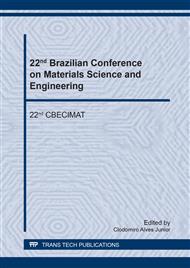p.400
p.405
p.411
p.416
p.422
p.428
p.434
p.440
p.445
Effect of Passivation Treatment on Adhesion and Protective Properties of Steel Coated with Polymeric Film
Abstract:
The surface of steel coated with Cr3+-based passivation layer and polyethylene therephtalate (PET) polymeric film was investigated by X-ray photoelectron spectroscopy (XPS) and atomic force microscopy (AFM). This coating was applied to the steel surface through a co-lamination industrial procedure. As well, the coated steel porosity was characterized by BET (Brunaer, Emmert, Teller) gas adsorption technique. Basic aspects of the polymer adhesion to the passivated steel were also studied by determining the force and energy adhesion between them. The AFM results showed that the PET coating presents roughness in the nanometer scale. XPS diagrams indicated the absence of surface contaminants and flaws on the applied coating and low contaminant levels on the Cr layer and absence of Cr6+ peaks after coating removal. This material can be a environmental compliant alternative to replace tinplate and Cr6+ conversion layer in the food industry, being compatible with the packed product.
Info:
Periodical:
Pages:
422-427
Citation:
Online since:
September 2018
Keywords:
Price:
Сopyright:
© 2018 Trans Tech Publications Ltd. All Rights Reserved
Share:
Citation:


